#jellyfish fact
Explore tagged Tumblr posts
Text
🪼Daily Cnidarian Fact:🪼
Bloodybelly Comb Jellyfish: The blood-red stomach disguises the glowing prey inside. Many of the deep-sea animals the bloody-belly comb jelly preys upon can bioluminesce, or create their own light. The translucent predator needs to conceal its stomach—or risk its most recent meal lighting it up from the inside out and alerting potential predators to its whereabouts. Red is nearly invisible in the deep sea, so the vibrant crimson that gives this comb jelly its name is actually helping it hide from its predators.


#bloodbelly comb jellyfish#bloodbelly jellyfish#bloodbelly#comb jellyfish#comb jelly#deep sea jellyfish#deep sea#daily jellyfish#jellyfish fact#jellyfish post#jellyfish#daily jellyfish fact#facts about jellyfish#cnidarian post#cnidarian fact#facts about cnidarians#daily cnidarian#daily cnidarian fact#cnidarian#respect the locals#marine animals#marine life#marine biology#marine life blog#marine life advocate#advocacy for marine life#marine#ocean animal#ocean life blog
316 notes
·
View notes
Text

Today’s Exhibit of the Day? The lion’s mane jellyfish (Cyanea capillata). Jelly-ve it or not, this critter is one of the world’s longest animals. This jumbo-sized jelly trails a “mane” of more than 800 stinging tentacles that are covered in cells with venom that stun prey, including other jellyfish, small crustaceans, and zooplankton. Just how long is the lion’s mane jellyfish? Well, its tentacles can grow more than 100 feet (30 meters) long! In fact, the longest examples of this species—which inhabit the Arctic Ocean—are even longer than the longest known blue whale. Come see a life-size model of one at the Museum’s Hall of Biodiversity.
Photo: R. Mickens/ © AMNH
#science#amnh#museum#nature#natural history#fact of the day#animals#did you know#jellyfish#lion mane#lions mane#ocean life#marine biology#marine biodiversity
693 notes
·
View notes
Text
can we talk about how tesseralia makes tres horny boys who they are and parallels them in story and song beautifully. magnus coaching a group of kids and encouraging them and telling them they can win when all the odds seem against them vs hoisting angus on his shoulders and telling him to let the world know they won. taako’s first profound experience of the bonds formed through cooking vs developing the power to fight the embodiment of despair and apathy through cooking a meal with somebody. merle’s first meeting with his greatest enemy who’s completely ideologically opposed to his commitment to love and joy vs his last moment with his old friend john appreciating the beauty of the world together
#magnus’ might seem like a bit of a stretch but idk i kinda see both of those as tying into his arc as the protector#also can we talk about the fact that magnus’ happy future in paloma’s last prophecy is angus#i feel like its so little to go off of cause its such a small moment but its so interesting#obviously taako is angus’ beloved teacher and mentor and they’re super close#but like… magnus is his dad. imo#(not that he can only have One parent. i think he’s also ‘parented’ by lucretia and carey & killian and to an extent taako+fam and merle)#angus representing magnus’ happy future directly compared to lup and merle’s kids to the other boys… there’s something there!#not to mention he clearly wants to have an emotional; familial; perhaps even parental moment w angus in giving him his grandfather’s knife#he raised a jellyfish son with lucretia Already they can coparent a human child just fine probably#taz balance#taz#the adventure zone#mine#thb#analysis#taako#magnus burnsides#merle highchurch
208 notes
·
View notes
Text
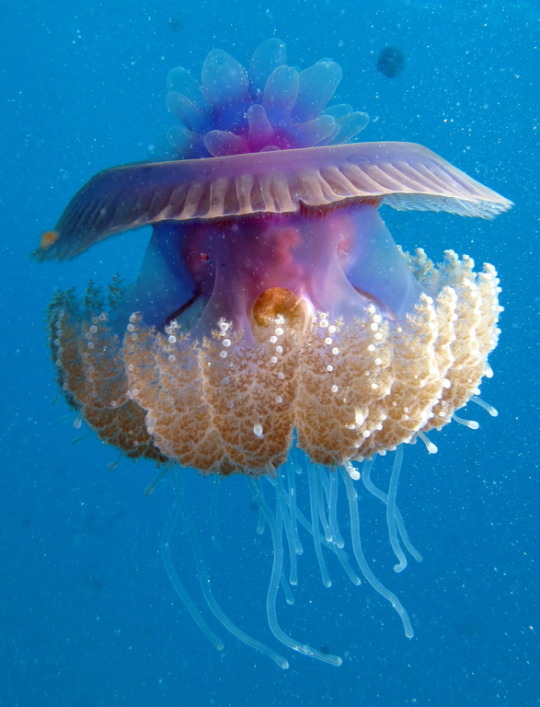

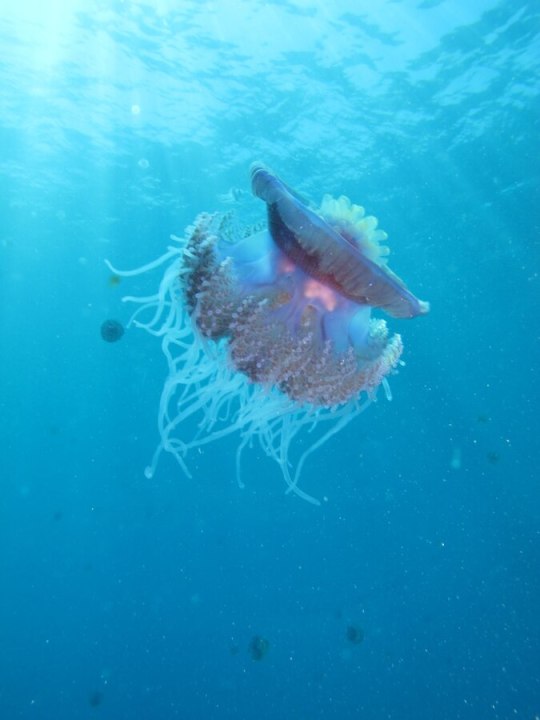
Bow Down to the Crown Jellyfish
The crown jellyfish (Cephea cephea), also known as the cauliflower jellyfish, is a species of jellyfish found primarily in the open waters of the Indo-Pacific Ocean, from the surface up to a depth of 915 m (3,000 ft). They spend most of the day in deeper waters, and then rise to the surface at night to feed.
Like most jellyfish, C. cephea is a filter feeder. The bulk of their prey consists of algae, shrimp, plankton, invertebrate eggs and invertebrate larvae. Although they are venomous, they are not considered a threat to humans. Rather, it's venom is designed to deter its natural predator, sea turtles.
The crown jellyfish is named for its distinctive appearance. The 'bell', or umbrella is bright purple, up to 60 cm (23 in) across, and situated in the middle is a bulb of multiple protruding round spikes. Beneath is a cauliflower-shaped mass, often white or yellow, from which the 30-40 thin tentacles descent. In addition to its bright coloring, the cauliflower jellyfish is also notable for being bioluminescent at night and in the darker depths of its range; the purpose of this light show is unclear.
C. cephea is a broadcast spawner, meaning that females and males both release their reproductive material into the open water. The fertilized eggs hatch into microscopic larvae, which then floats through the ocean for months or even years until it encounters a rock, coral, or other sedentary object. There, it grows into a structure called a polyp that filter feeds on passing plankton for another several weeks. When it gets big enough, it undergoes strobilation, in which layers peel off to become tiny jellyfish. These baby crown jellyfish grow extremely quickly, starting at only 2-3 mm (0.07-0.11 in), but grow to to 1.7 cm (0.66 in) in only a few weeks. Once they reach their adult size, they only live for 3-6 months.
Conservation status: The crown jellyfish has not been listed by the IUCN. Due to its large population size and range, it is considered stable, and may even be expanding its range due to warming oceanic waters.
Photos
Derek Keats
Alexia Pihier
#crown jellyfish#Rhizostomeae#Cepheidae#medusae jellyfish#jellyfish#cnidarians#invertebrates#marine fauna#marine invertebrates#pelagic fauna#pelagic invertebrates#open ocean#open ocean invertebrates#Indian Ocean#Pacific Ocean#indo-pacific#animal facts#biology#zoology#ecology
270 notes
·
View notes
Text
apparently pjotv twt was being weird about book!Percy's eyes being green because they don't think the ocean can be green (???) so consider this a sequel to my Grace siblings eye colors post and here is some visual references of green water for all your Percy inspo needs:
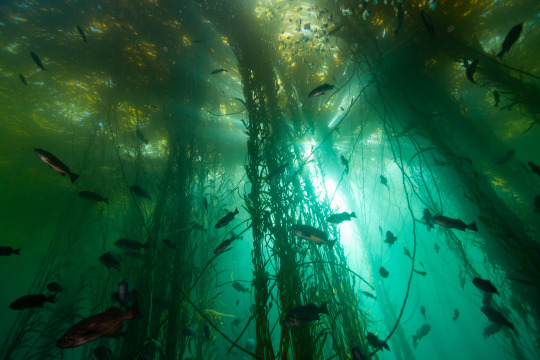



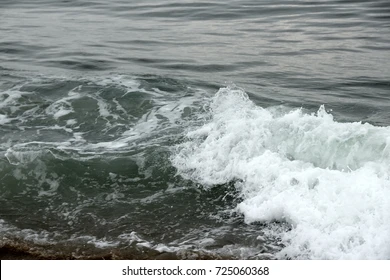

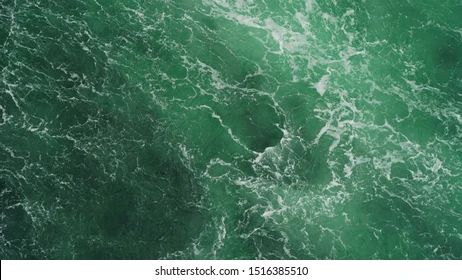



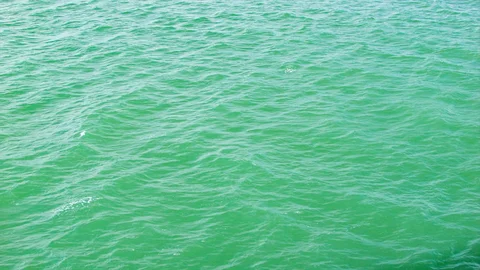

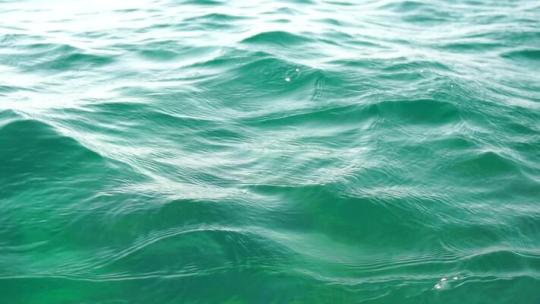






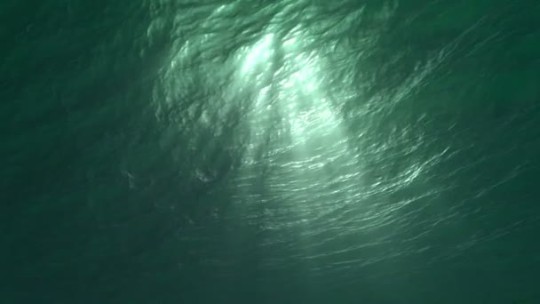
And for reference, the water around New York-ish where Percy is usually is somewhere around this color:

or some alternatives:

or here is a nice hazel green if you want his eyes more on the brown side, which is very common in freshwater ponds and streams:


or if you want him to have totally brown eyes - water rich in tannins will appear brown, greenish-brown, or very dark brown - this is sometimes called "blackwater" due to often appearing very dark or having low visibility:



#pjo#percy jackson#riordanverse#i am eternally amused by old pjo fandom's tendency to interpret ''sea-green'' as ''tropical seas / neon aqua''#mostly just cause as someone who grew up around boats when i think of ''sea-green'' i have a very particular color in mind#and its that kind of murky desaturated green#like sometimes ur at the docks and are just shoving your hand into low visibility green water to catch jellyfish yknow#thats the vibe. thats what i think of whenever i hear ''sea-green''#reach into your local harbor and you may find a friend and a boy (jellyfish)#and i respect not everybody is as familiar with the ocean but ''Percy's eyes being blue is *better* because the ocean is blue not green!''#is. just a ridiculous statement to me.#like. just. first and foremost. claiming blue eyes are ''better'' and the implications in that (bleugh)#secondly - claiming that ''the ocean isnt GREEN'' is just. well you're just wrong so jot that down#it is in fact not uncommon for the ocean to be green. this is very normal actually#the ocean not always being blue does not feel like particularly groundbreaking news????#like gonna be real my guy usually the ocean is actually pretty. idk. greyish.#especially if its not actively a very sunny day in the summer#cause a lot of the time if the water is just reflecting the sky and is not being particularly affected by whatever is actually in the water#then. well. the sky is usually greyish! on your average day the sky is usually kinda grey! it usually only gets really blue when its sunny#but usually water has. yknow. stuff in it. a lot of the time algae and such. so it ends up murkier/greenish#anyways this has been: AALV's oddly specific nitpicking about Percy's eye color
304 notes
·
View notes
Text
Wet Beast Wednesday: box jellyfish
Jellyfish are curious things, but some are curiouser than others. Most jellyfish are members of the class Scyphozoa, which is a very diverse clade with plenty of jellies to choose from. But then there are the Cubozoa, a separate class of jellyfish that have a lot of interesting and unique features, such as being some of the most venomous animals in the world. Try not to get stung.
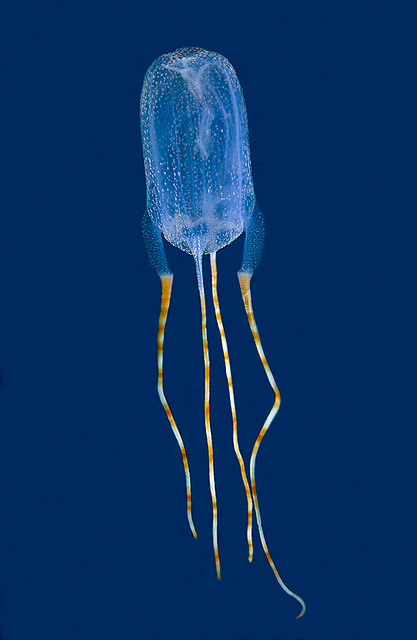
(Image: a box jellyfish. It is a mostly translucent jellyfish with a box-shaped bell. From the corners of the bell hand four tentacles that are a striped white and orange. End ID)
Like the Scyphozoa, the approximately 50 known species of box jellyfish have a body plan consisting of a bell and trailing tentacles. While the Scyphozoa have round bells, box jellyfish have cuboid bells, which give them their name. At each lower corner of the bell is a stalk that leads into one or more tentacles. The interior of the bell is divided into four regions by structures called septa. In each region is a gastric pocket that helps direct food into the central stomach and has structures that help water flow into and out of the animal. Each septa is lined with digestive filaments and two of the jellyfish's eight gonads. In the center of the bell is a flexible, trunk-like appendage called the manubrium which contains the mouth and stomach. When thebox jellyfish eats, it draws prey into the one of the septa where the digestive filaments begin digestion. The manubrium then maneuvers the mouth over to the prey and eats it. Prey is captured with the tentacles, which are lined with stinging cells called cnidocytes which contain structures called nematocysts that inject venom into prey and threats. The tentacles then help move the food into the bell. While Scyphozoa come in a variety of colors, box jellyfish are almost always translucent.
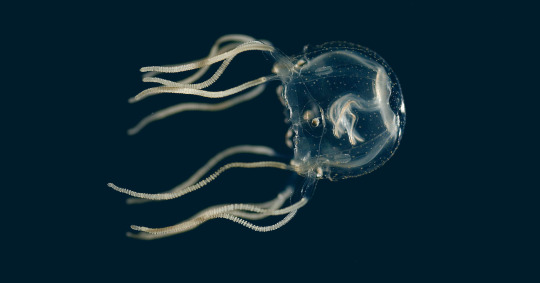
(Image: a box jellyfish, this one having a squatter bell and multiple tentacles at each corner. The manubrium is visible through the bell as a curving, trunk-like structure. End ID)
Box jellyfish have a developed nervous system consisting of two portions: the nerve ring and the rhopalia. The ring nerve stretches around the base of the bell and controls how it moves. The rhopalia is a system of nerves that controls sensory structures. In particular, it controls a sense of gravity and the eyes. While some Scyphozoa have simple light-sensing eyes, the box jellyfish have true eyes with retinas, corneas, and lenses. Like the bell, the rhopalium is divided int four segments. Each segment has two true eyes as well as two simple pit eyes for detecting light levels and two simple slit eyes that likely detect movement. The true eyes can be oriented in different directions and they always appear to keep one pair pointing up. Thanks to their good eyesight and the shape of the bell allowing for rapid bursts of speed, the box jellyfish can actively hunt its prey instead of just drifting and waiting for food to come to them. What's more impressive is their ability to actively navigate their environment and learn to avoid certain threats. It was long thought that animals without brains would not be able to truly learn, but multiple types of cnidarians have shown learning behavior, with the box jellyfish seeming to be the most advanced.
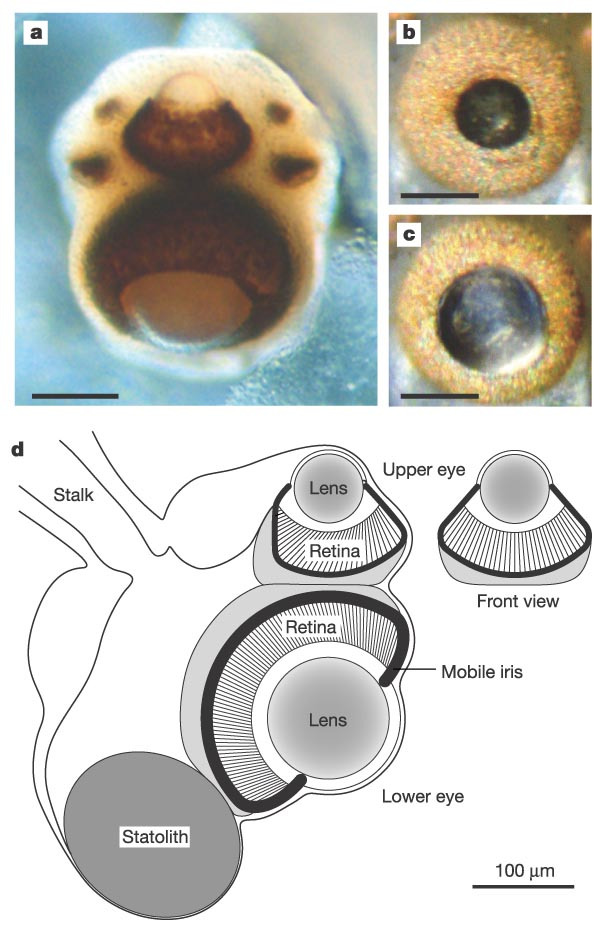
(Image: a scientific diagram showing pictures of a box jellyfish eye and a drawing of its anatomy. End ID. Source)
Box jellyfish reproduce every year and are semelparous, meaning they only mate once before dying. However, there is some inconclusive evidence that the species Chiropsalmus quadrumanus may be able to mate multiple times. Reproduction can be both internal and external depending on species. In external reproduction, the male and female release gametes into the water. In internal reproduction, the pair will maneuver themselves so the openings of their bells face each other and the male will pass a packet of sperm to the female. In these species, the female retains the eggs internally until they hatch. The juveniles hatch as a type of swimming larva called a planua. The planua will eventually settle and become fixed to a hard surface, metamorphosing into a polyp. The polyp is a non-swimming stage found in all members of the clade Medusuzoa, of which the box jellyfish are a member. Polyps will grow for months to years and during this period, they can reproduce asexually by budding off clones of themselves. Eventually, the polyps will metamorphose into the adult medusa stage
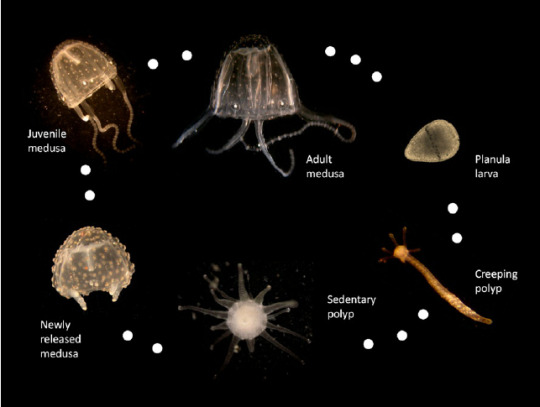
(Image: photos of a box jellyfish at different stages of its life cycle. It starts as a bean-shaped planula, progresses to a worm-like creeping polyp, then to an anemone-like sedentary polyp, then to a newly released medusa, which looks like a tentacle-less box jellyfish. The medusa them matures to a small juvenile and finally a mature adult. end ID)
Box jellyfish are found worldwide in tropical waters, though most known species are from the Indo-Pacific. It is likely that many species ave been overlooked as their transparency and frequently small size makes it easy to miss them. New studies using e-DNA, DNA that is shed and collected through the environment, may help identify nee species and populations. Box jellyfish are known to most people as being some of the most venomous animals in the world, but only a few species are dangerous to humans. The species Chironex fleckeri is the most dangerous to humans. Its venom causes extreme pain and can lead to death within 2-5 minutes if enough venom enters the system. C. fleckeri has caused over 60 recorded deaths in Australia (because where else would it live?) and while there is now an antidote to the venom, getting it to the victim fast enough can be challenging. A singe C. fleckeri is often said to carry enough venom to kill 60 people. Most reported cases of stings have not ended in death as not enough venom was introduced to the system. Also from Australia (of course) are the Irukandji, a group of about 16 similar box jellyfish that can also be lethal, but while C. fleckeri at least has the decency to be big, the Irukandji jellyfish are all tiny. Their venom causes a reaction called Irukandji syndrome that is delayed for up to 2 hours after the sting and can lead to cardiac arrest if not treated. Jellyfish nets are common sights on Australian beaches. They enclose parts of the water with nets that have mesh small enough to keep most jellyfish out. Application of vinegar to the sting is the current recommended treatment and many beaches in Australia are required to stock it, though some research has indicated that vinegar may actually make the sting worse.

(Gif: footage of the rare spotted box jellyfish. It has a large bell with stripes and rings on it and the tentacles are thick and reddish. It is swimming, showing off the movement of the bell in how it propels itself. End ID)
#wet beast wednesday#I wanted to make a fakemon based on these for my australia region#but couldn't think of anything that tentacruel and nihilego haven't covered already#box jellyfish#jellyfish#cubozoa#medusozoa#cnidarian#invertebrates#invertblr#venomous#marine biology#biology#ecology#zoology#animal facts#educational#informative#image described
179 notes
·
View notes
Text
I've been seeing a lot of Goochy content on tumblr and that makes me really happy, so I wanted to share my collection of Goochys (Goochies?)!
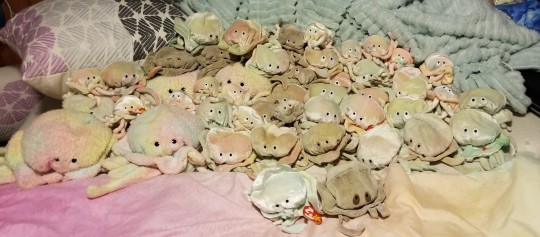
The two in front are my second newest and oldest Goochys, the oldest is around 20 now. Since this picture I've gotten one or two more. Idk I just love Goochy a lot!! And as a kid my life goal was to have the biggest collection of them in the world and I don't think that's changed
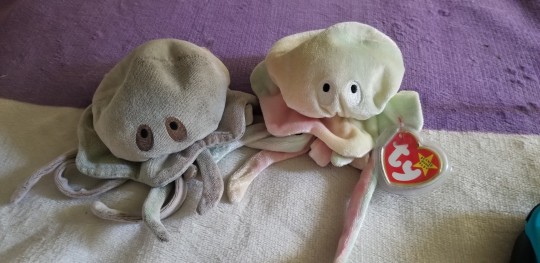
Have an extra picture: close-up of the same oldest Goochy, and my most recent one not in the first pic
(:。)ミ
#fun fact: goochy had the most expensive fabric to produce at the time#cause of the shimmery effect and the multicolors#idk if thats why it got retired but interesting regardless#and goochy comes in a rainbow color or a blueish#some of mine are gray cause theyre well loved ♡#goochy the jellyfish#goochy#beanie babies#beanie baby#cotton talks
2K notes
·
View notes
Text
Fish of the Day
Today's fish of the day is the flower hat jelly!
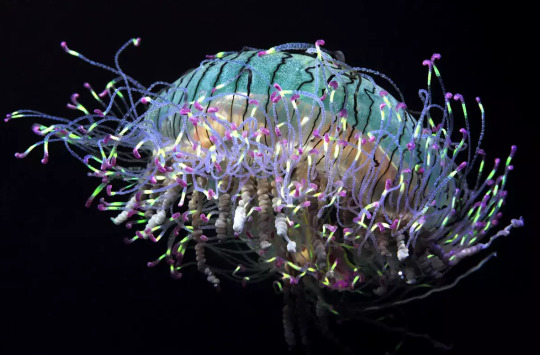
The flower hat jelly, scientific name Olindias formosus, is a small and rare jelly known for the multicolored tentacles and luminescent display. Belonging to the hydrozoa family, the flower hat jelly is not actually a true jellyfish. The main difference between them being that true jellyfish belong to the Scyphozoa class, and have a life cycle defined by a longer period as a medusa (their adult form) whereas hydrozoans have a lifecycle primarily defined by their polyp or juvenile stages, sometimes even lacking medusa forms, a pattern that can once again be found in the flower hat jelly's life cycle. Their distribution is off the coastline of Japan, Korea, and countries within Oceania. Although some believe that these jelly's can also be found outside of Argentina, and Brazil, it is thought this may be a close relative, Olindias sambaquiensis. With a depth range from sea level down to 55m of depth, these jellyfish tend to live near the ocean floor where they can hide among kelps, sea grasses, and loose rocky bottoms.

Living a nocturnal life, the flower hat jelly spends its days hiding on the ocean floor. But, once dusk arrives this jelly rises from its hiding places to capture small fishes within its tentacles, paralyzing and or killing the fish, before drawing the corpse up into the bell to be consumed. The stings from this jelly are painful, and at least one fatality has been recorded from them in Japan. These tentacles hold most of the intrigue of the flower hat jelly. The length of the tentacles may appear to be random, but has been found to be arranged mathematically in an optimization hashing algorithm known as fibonacci hashing. Length aside however, these jelly's, and especially their tentacles contain fluorescent proteins, which are used to attract prey when hunting, and are particularly bright under blacklight. This protein is uniquely interesting due to its use in helping treat some COVID cases, as it can be used as an inhibitor, stopping the replication of the disease, and slowing or halting its spread.

The reproduction and younger stages of the flower hat jellyfish were a mystery for many years, but in 2012 the Monterey Bay Aquarium managed to be the first to breed them in captivity, capturing a full lifecycle from larvae to polyp to medusa. Beginning as polyps attached to a hard surface along the seabed, where they are completely stationary, surviving off of a single active tentacle, which is waved back and forth to gather nutrients, forming a medusae and releasing them only once a size of 1mm was achieved. Then they will mature into juvenile medusa, which are identical to adult medusa in appearance and behavior, only being identifiable by their smaller size and less tentacles. Juvenile medusa only being around 2-20mm, and adults getting only as large as 6inches total throughout their lifespan. Adult flower hat jellies are only observed in the months of December-July with peaks in the months of May and April. However, we understand very little about how these jelly's sexually breed in the wild, but fertilization occurs externally, as gametes are released into the water to create small, non-cooperative colonies along similar areas. These animals live only 4-6 months as adults, and only around a year total before slowly losing their fluorescence and passing away.

That's the flower hat jelly, everybody, have a wonderful Tuesday!
#ish#fish of the day#fishblr#fishposting#aquatic biology#marine biology#freshwater#freshwater fish#animal facts#animal#animals#fishes#informative#education#aquatic#aquatic life#nature#river#ocean#fish#jellyfish#jelly#flower hat jelly#hydrozoan
136 notes
·
View notes
Note
MERRY CHRISTMAS :D
MERRY CHRISTMAS TO YOU TOO!!!!

Have some Classic Amy x Classic Organic Metal Sonic (my ver.) because I'm also a Metamy shipper :)
#I made this before especially for you#but I didn't have time to post it.#sonic the hedgehog#sth fanart#sth art#sth#sonic the hedgehog fanart#sonic art#sonic#sonic au#classic amy#classic amy rose#metamy#organic metal sonic#metal sonic#plastic bag jellyfish#bymiar#merry christmas#When I can take a better photo I might update the post#Fun fact: I was originally going to start on tumblr by posting this Metamy au...
78 notes
·
View notes
Note
In my book, mermaids use bioluminescent animals to help navigate the dark corridors of their boarding school. They are more decorations than functionals, but do you know any beautiful bioluminescent animals I can use? Also can you suggest animals some of the students use as attendant lifeforms (familiars/? Thanks.
If you're using the bioluminescent creatures as lights I HIGHLY recommend jellyfish! More than half of the jellyfish species produce some sort of bioluminescence.



In regards to familiars, my first recommendation is any kind of octopus! They're highly intelligent, fast, and flexible! There is also a bioluminescent octopus (Stauroteuthis syrtensis)



Personally I also think a little shrimp could be a cute pet/familiar! Small enough to perch on their shoulder or hide in their hair, clean up any parasites.


I could come up with a whole bunch of ideas! If you want to talk more about it please DM me, I'd love to talk more about it and find out more about your book!
#marine biology#marine ecology#animals#science#biology#animal facts#wildlife#marine life#ocean#bioluminecent#bioluminescence#jellyfish#shrimp#octopus#cephalopod
133 notes
·
View notes
Text
🪼Daily Cnidarian Fact:🪼
Atolla Jellyfish: Also known as the Coronate medusa and deep-sea jellyfish, this is a species of deep-sea crown jellyfish. It typically has 20 marginal tentacles and one hypertrophied tentacle which is larger than the rest. This long trailing tentacle is thought to facilitate prey capture. This species is bioluminescent. When attacked, it will launch a series of flashes, whose function is to draw predators who will be more interested in the attacker than itself. This has earned the animal the nickname "alarm jellyfish".


#atolla jellyfish#deep sea crown jellyfish#deep sea jellyfish#alarm jellyfish#jellyfish#jellyfish post#daily jellyfish#daily jellyfish fact#facts about jellyfish#jellyfish fact#cnidarian#cnidarian fact#cnidarian post#daily cnidarian#daily cnidarian fact#facts about cnidarians#respect the locals#deep sea#marine animals#marine biology#marine life#marine life blog#marine#ocean animal#ocean life#ocean life blog#ocean#advocacy for marine life#marine life advocate
265 notes
·
View notes
Text

What has no heart and no brain? No, it’s not your ex… it’s the barrel jellyfish (Rhizostoma pulmo). Also known as the dustbin-lid jellyfish (yes, really), this species can reach an impressive 35 in (90 cm) in diameter and can weigh up to 77 lbs (35 kg)! Like other jellies, this critter relies on its nervous system to function.
Photo: tato grasso, CC BY-SA 3.0, Wikimedia Commons
#science#nature#natural history#animals#fact of the day#did you know#jellyfish#ocean life#marine biology#fun facts#animal facts#cool animals
1K notes
·
View notes
Text
have some kinitoPET content, 'cause why not

a version with YOU

+ a thing and a few YOU doodles
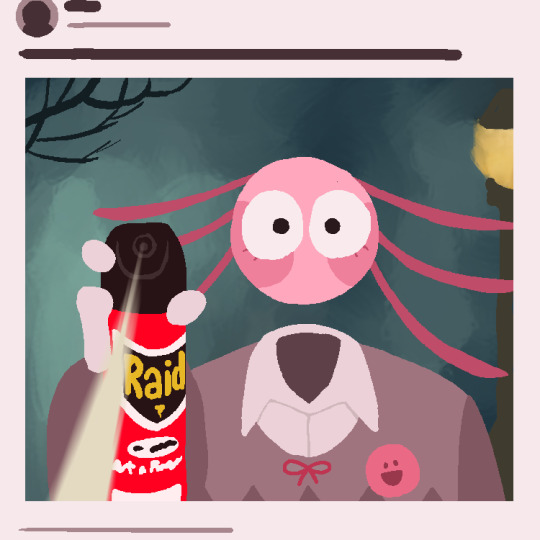
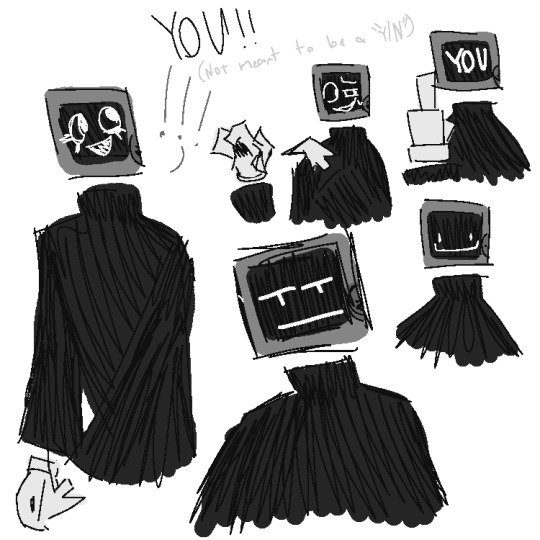

#silverware's art#kinitopet#kinito the axolotl#sam the sea anemone#jade the jellyfish#YOU#(yeah that's what i'm gonna call them)#all caps names are great. dontcha think?#750 pixel by 750 pixel canvases are usually what i draw on and some of these are bigger. i'm not too used to that-#i thought it would be important to mention they're not meant to be a Y/N. they are their own person- that being some random enby person#and their web world avatar CAN emote! however! WHENEVER THEY WANT! ('less they like. forget to actually have the screen display on-)#if they forget (or just don't wanna be like. really fucking expressive i guess-) it just says “YOU”#they all have a smily pin!! (well- YOU has a sticker but whatever-) and yes. kinito having it on his left#and the others having it on their right was.#very intentional#over the heart :)#also YOU having it on the left side!! (i imagine kinito made their avatar and made it match!)#FUN FACT! YOU can change the colour of the display! they just picked white (ik it's off white. but idc) because they know the HEX code#anyways. imma stop yapping lol
398 notes
·
View notes
Text
Uncharismatic Fact of the Day
Ghost, phantom, or spirit? The giant phantom jelly is none of those things! Stygiomedusa gigantea is most commonly found at depths of 6,665 m (21,867 ft), making it a rare and haunting sight; so rare, in fact, that it's only been spotted 114 times in the last 110 years. Not much is known about this species, save that it's one of the largest invertebrate predators of the deep, reaching up to 1 m (3.3 ft) across and 10 m (33 ft) in length!
Check out the video below to get a full view of this ghostly apparition:
youtube
#giant phantom jellyfish#Semaeostomeae#Ulmaridae#jellyfish#true jellyfish#cnidarians#invertebrates#uncharismatic facts#Youtube
80 notes
·
View notes
Text
Jellyfish do not have a single centralized brain, but they do have nervous systems that are spread out radially throughout their bodies. These nervous systems are made up of about 1,000 processing neurons in adult jellyfish and can show some degree of neuronal condensation, which acts as an integrative nervous system. For example, box jellyfish have clusters of neurons associated with their eyes.

#fish facts#fish#sea animals#animal facts#animals#random facts#facts#fun facts#sea lover#jellyfish#endos dni#minors dni#proship dni
113 notes
·
View notes
Text
Welcome to a topsy-turvy Wet Beast Wednesday where I'm discussing one of my favorite cnidarians, the upside-down jellyfish. These are 8 species of jellyfish in the genus Cassiopea, which is the only member of the family Cassiopeidae. What makes these jellies notable is the fact that they spend most of their time lying upside-down on the seafloor.
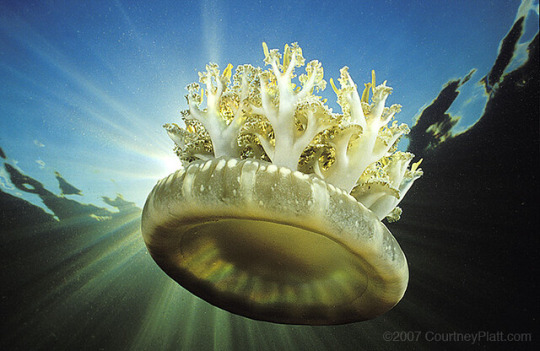
(image: an upside-down jellyfish swimming. It has a light brown and white striped bell and multiple tentacles that are tuck and white. The tentacles branch and are lined with feathery, light brown structures)
While the majority of jellyfish are predators who drift through the water at the mercy of the currents, upside-down jellyfish have essentially become farmers. Their eight branched oral arms that contain symbiotic algae called zooxanthellae. These algae are photosynthetic and live in a mutualistic relationship with the jellyfish. The jellyfish gets food from the zooxanthellae and they get protection from predators and a place to live. Upside-down jellyfish can survive entirely on the nutrients produced by the zooxanthellae, but they will still feed on zooplankton and other small prey. Upside-down jellies are not the only jellyfish to utilize zooxanthellae, many other species also survive primarily on their symbiotic algae, but they are the only ones to have adapted the benthic lifestyle. They can reach a bell diameter of up to 25 cm (10 inches), or as one source for this stated: about the size of a pie pan.
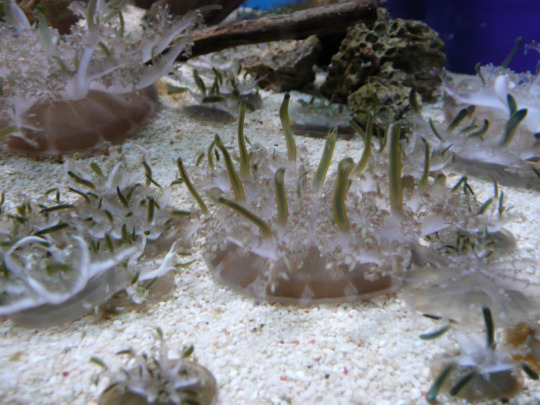
(image: multiple upside-down jellyfish lying on sand. They are ov various sizes and mostly light brown, but have thicker, green tentacles sticking op)
Upside-down jellyfish are found in warm coastal waters in Florida and the Caribbean and in Micronesia, Melanesia, and parts of Polynesia. They require shallow waters to allow enough light to reach their zooxanthellae and are usually found on shady or muddy bottoms. They are highly associated with mangroves and may play an important role in the mangrove habitats by mixing the water to recirculate oxygen and nutrients. They are rarely found alone, instead congregating in large groups that can cover portions of the seafloor. They attach by using their bells as suction cups and rhythmically pulse using the edges of the bell. This pulsing forces water over the gills and can force zooplankton into the stinging cells to become food. Stung prey will fall on the oral tentacles, where it is broken down into fragments that are then intaken through the numerous tiny oral openings on the tentacles. Interestingly, some species have cycles of reduced movement, which is believed to be the first known example of sleep in an animal without a central nervous system. While upside-down jellies can swim, they will usually only do so to escape predators or if their environment becomes unsuitable.
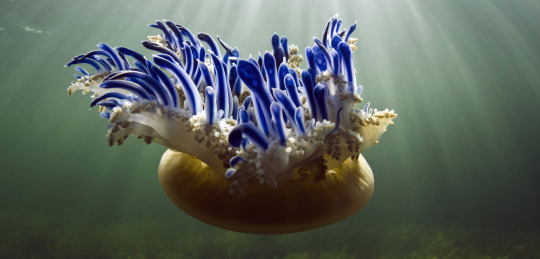
(image: an upside-down jellyfish swimming. The majority of its body is light brown, but it has many tentacles that are dark blue and outlined in white)
While a very neat thing to see underwater, many snorkelers avoid upside-down jellyfish due to a phenomenon called stinging water. This is when people will receive the symptoms of a sting by the jellyfish without actually touching it. While the cause of this was a mystery for a long time, it was solved when a 2020 paper was published in Communications Biology by Ames et al. The scientists discovered that upside-down jellies release clumps of mucus into the water. This mucus is filled with zooxanthellae and stinging cells and many of these clumps also have ciliated cells that allow for limited swimming. These clumps, named cassiosomes, are the source of the stinging water. The paper, titled "cassiosomes are stinging-cell structures in the mucus of the upside-down jellyfish Cassiopea xamachana" speculated that the cassiosomes are used for defense and feeding. The cassiosomes could be released to sting a potential predator from a distance, discouraging it from approaching the jellyfish. Presumably snorkelers trigger this defense when they swim over the jellies, resulting in stinging water. They could also be used to catch prey as zooplankton killed by the stinging cells would have a high likelihood of falling onto the jelly that released them. Because the cassiosomes have zooanthellae in them, they could survive for likely up to several days after release.

(image: a microscope image of three cassiosomes. They are irregularly-shaped blobs somewhat similar to popcorn. They are a dark color with grey outlines. Spots of green algae and white stinging cells dot their surface)
Upside-down jellyfish are threatened by habitat loss as many mangrove forests are torn down for development. They are also threatened by pollution. They are not considered dangerous to humans. The sting of an upside-down jellyfish can result in mild to severe rashes and itching, but is not lethal.
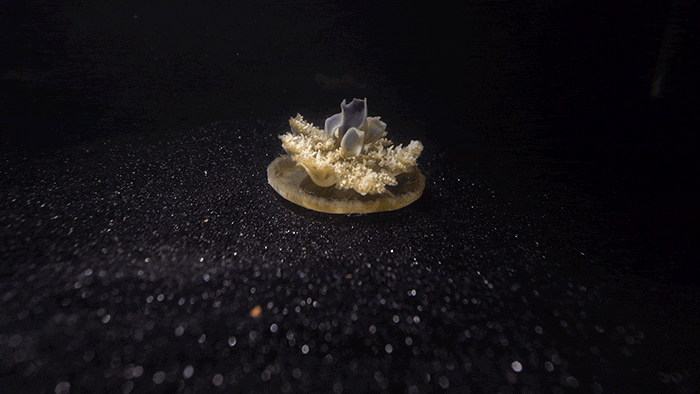
(gif: a lone, light brown upside-down jellyfish on black sediment. The edge of its flat, circular bell regularly pulse upward to move air over its gills and tentacles. This one's pulsing has slowed, which is speculated to be the result of it going through its sleep cycle)
#wet beast wednesday#upside down jellyfish#inverted invertebrate#marine biology#biology#zoology#ecology#animal facts#jellyfish#cnidarians#invertebrate
842 notes
·
View notes